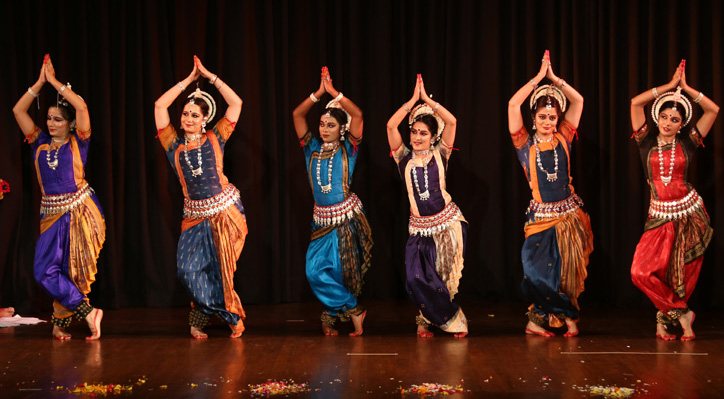 New Delhi:
New Delhi: BHOOMI PRANAM 2015, an evening of Odissi Dance was organised by Association for Learning Performing Arts and Normative Action (A.L.P.A.N.A.) at Main Auditorium, India International Centre (IIC), New Delhi on 23 August 2015 where senior disciples of Guru Smt Alpana Nayak presented "Nartaki ", a special choreography based on Acharya Nandikeshwara's "Patra Lakshyanam" from Abhinaya Darpana and other traditional Odissi Dance Pieces.
A.L.P.A.N.A.is registered under the Societies Registration Act 1860. It is working since 2003. The Society aims at promotion of performing arts and working towards equitable human development and growth. The emphasis is on inclusive growth and composite heritage.
Mr Devendra Chaudhry, IAS, Secretary, Dept. of Administrative Reforms & Public Grievances, Govt. of India was the Chief Guest and Sangeet Natak Academy Awardee Odissi Guru Shri Shudhakar Sahoo was the Distinguished Guest of the evening. After the lighting of the ceremonial lamp by the guests the performances started.
Traditionally an Odissi dance recital starts with Mangalacharana, where the dancer dedicates herself to the Almighty and begs forgiveness from Mother Earth for stamping feet on her, begs apology from the audience for any shortcomings and pays obeisance and seeks blessings from her Guru.
In Mangalacharana dancers began with a prayer to Goddess Saraswati - Manikya Veena Mupala Layanti…….. written by Mahakavi Kalidasa. In this shloka the Goddess has been depicted as “Jagat Janani”, “Vak Vilasini”, “Sangeet Rasike” and “Kalyani.”
The artists were Amrit Setia, Disha Kannan, Vaishali Saini, Prapti Gupta, Pihu Shrivastava, & Devika Seth.
Then the dancers presented “Nartaki” based on Acharya Nandikeshwar’s “Patra Laksanam – Characteristics of Dancer” from Abhinaya Darpana.
A woman is considered a “Nartaki” if she possesses the following qualities: proper stature, charm, dun color with full-rounded breasts, self confidence, playful nature, agreeableness, expert in beginning and ending critical passages, skilled in chari movements, rhythm and laya, skilled in mandalas, expert in using hastas, various limbs or angarasa and sthanakas, graceful in handling karanas, has big eyes, ability to follow the song being rendered along with instruments and tala, adorned with best jewels, and charming with lotus like face.

According to the rules laid down by the treatise the following are the ten inner aspects of the life of a dancer:
Swiftness, composure, symmetry, graceful execution of bhramaris, good looks, ease, intelligence or retentive faculty, devotion or concentration, is well spoken and a singer. The dancer having these ten inner aspects has to proceed with presentation of dance.
This item was specially choreographed by Smt. Alpana Nayak and was presented by Amrit Setia, Prapti Gupta, Disha Kannan, Pihu Shrivastava, Vaishali Saini, Devika Seth and Tanvi Datta.
The next item was “Vrindavani Sarangi” Pallavi. The word “Pallavi” has been derived from the Sanskrit word “pallava”, which means the bud of a leaf, or the shoots of a tree, which are very tender. As a small seed grows gradually into a large tree, in Pallavi, a tune is sung in a particular raga and it develops gradually into different varieties. In this item equal importance is given to dance as well as music and rhythm. The movements in this item are extremely graceful and lyrical.
The dancers were Amrit Setia, Prapti Gupta, Devika Seth, Tanvi Datta and Pihu Shrivastava. This item was choreographed by Miss Ayushi Nayak, Shri Santosh Swain and Smt. Alpana Nayak.
Abhinaya, the most important part of an Odissi repertoire is an expressional dance where a story is conveyed to the audience through Hasta mudras, Drishti bhedas, Griva bhedas and Shiro bhedas. In Bhoomi Pranam 2015 Abhinaya was based on an Oriya Song “Bhangi Chahan”, which is “Bha” letter Champu written by Kabi Surya Baladeva Ratha. In this song sakhi (the friend of Radha) is describing the heavenly beauty of Lord Krishna’s different postures to Radha. But Radha is not impressed with her description and trying to defy her with reasonings.
The Abhinaya was presented by Prapti Gupta, Disha Kannan & Pihu Shrivastava
The Last item of the evening was Moksha in which the dancers prayed for salvation. Moksha means “spiritual liberation”. This dance represents a spiritual culmination for the dancer who soars into the realm of pure aesthetic delight. The dance moves onto a crescendo that is thrilling to both, the eyes and the ears. With the cosmic sound of “Om”, the dance dissolves into nothingness — just like Moksha or the deliverance of the soul in real life.
The accompanists were Sri Prasanta Behera (Vocalist), Sri Prafulla Mangaraj (Mardala), Sri Dhiraj Pandey (Flute) and Sri Lavinya Ambade (Sitar).
Mr Devendra Chaudhry who was the Chief Guest at the event said that India’s Cultural Diplomacy is now in the hands of very young generation, who despite the global influences, have been taking keen interest in traditional art forms of India. We must give them support and encouragement. He also appreciated Smt. Alpana Nayak’s efforts for inculcating cultural values in the youth and promoting it further.
 New Delhi: BHOOMI PRANAM 2015, an evening of Odissi Dance was organised by Association for Learning Performing Arts and Normative Action (A.L.P.A.N.A.) at Main Auditorium, India International Centre (IIC), New Delhi on 23 August 2015 where senior disciples of Guru Smt Alpana Nayak presented "Nartaki ", a special choreography based on Acharya Nandikeshwara's "Patra Lakshyanam" from Abhinaya Darpana and other traditional Odissi Dance Pieces.
New Delhi: BHOOMI PRANAM 2015, an evening of Odissi Dance was organised by Association for Learning Performing Arts and Normative Action (A.L.P.A.N.A.) at Main Auditorium, India International Centre (IIC), New Delhi on 23 August 2015 where senior disciples of Guru Smt Alpana Nayak presented "Nartaki ", a special choreography based on Acharya Nandikeshwara's "Patra Lakshyanam" from Abhinaya Darpana and other traditional Odissi Dance Pieces. 
